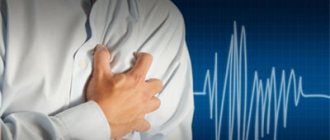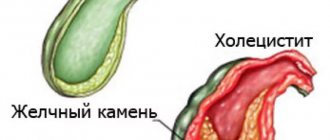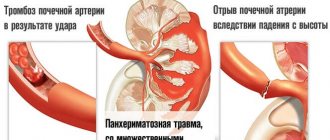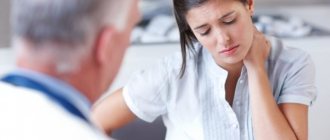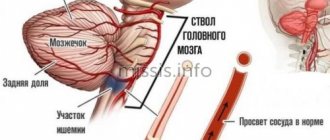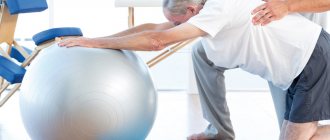Cardiac causes of sinus tachycardia
The main way to regulate heart rate is an electrical impulse sent by the sinus node located in the heart.
This impulse spreads to all the muscle fibers of the heart and causes them to simultaneously contract: thus, the main function of the organ is realized - to push portions of blood through the great vessels. Disturbances in the functioning of the sinus node are caused by the influence of various substances (hormones, chemical compounds). With sinus tachycardia, the number of heartbeats usually ranges from 90 to 120 beats per minute, in some cases it reaches 150 to 160. Sinus tachycardia sometimes appears during eating, during physical activity or emotional stress. It occurs in various diseases and is accompanied by symptoms characteristic of them.
Thus, rapid heartbeat is a common occurrence with myocarditis (inflammation of the heart muscle) of various origins. In this case, along with rapid heart contractions, the following appear:
- sensations of heart failure,
- arrhythmia of heart contractions,
- dyspnea,
- chest pain,
- weakness and fatigue,
- joint pain (not always),
- slight increase in body temperature.
Also, sinus tachycardia often occurs with heart failure, which may be a consequence of coronary disease or heart defects. In such cases, rapid heartbeat is also combined with shortness of breath, weakness and increased fatigue, which is often accompanied by swelling of the lower extremities. If such symptoms appear, you should contact a cardiologist as soon as possible. Once the underlying disease is eliminated, the tachycardia will also disappear.
In addition, rapid heartbeat is one of the symptoms of anemia. With anemia, due to a lack of hemoglobin, the delivery of oxygen to the tissues is reduced. As a compensatory response, the sinus node begins to generate more electrical impulses, the heart beats faster, and blood begins to circulate faster to bring the missing oxygen to the tissues. Tachycardia with anemia is accompanied by a number of additional symptoms:
- shortness of breath,
- weakness and dizziness,
- "flies" before the eyes,
- pallor (sometimes cyanosis) of the skin,
- chilliness,
- hair loss and brittle nails,
- tingling on the tip of the tongue,
- numbness of the limbs.
If you have tachycardia and most additional symptoms, you should first consult a physician. After donating blood to determine the level of hemoglobin and serum iron, the doctor will accurately determine whether there is anemia. If anemia occurs, consultation with other specialists may be required to determine the true cause of the disease.
Arterial hypotension is a condition in which sinus tachycardia occurs. It is often preceded by severe emotional stress, disturbances in sleep and wakefulness, and malnutrition. In addition to increased heart rate, hypotension is characterized by drowsiness, irritability, apathy, memory loss, headache, nausea and dizziness. In this case, you should pay attention to your lifestyle: normalize your diet, daily routine and physical activity.
An increase in heart rate is associated with intoxication. Abuse of drinks containing caffeine (coffee, tea, energy drinks), as well as certain medications, leads to sinus tachycardia.
What to do and what not to do with tachycardia
The patient’s condition depends not only on the handfuls of pills taken, but on his actions, because the local therapist cannot sit at the head of such a patient every minute to provide assistance to him.
Patients must firmly understand what to do and what not to do during tachycardia.
What not to do with tachycardia:
- drink drinks containing caffeine and other stimulants, as well as alcohol;
- smoking (even one cigarette every six months is prohibited);
- lean on salty foods (it’s better to avoid them completely);
- work hard in the gym doing an intensive program;
- self-medicate (for example, for supraventricular tachycardia, take medications for junctional tachycardia);
What to do:
- develop the habit of measuring your pulse, and don’t be lazy about drawing up daily curves (they will be useful for a doctor’s analysis);
- lean on fresh fruits and berries (especially lingonberries, raspberries, viburnum);
- perform light exercise, but regularly;
- eat in moderation - a full stomach pushes up the diaphragm, which in turn puts pressure on the heart, interfering with its work - this is the answer to the question of whether there can be tachycardia after eating;
- adjust the mode of work, rest, sleep, nutrition, sex.
Such simple actions can prevent severe forms of tachycardia. You can get more detailed answers to your questions (for example, what is ventricular tachycardia of the heart and what is it fraught with, when antiarrhythmics are prescribed, and so on) by opening our website https://www.dobrobut.com/.
Causes of paroxysmal tachycardia
In addition to sinus tachycardia, paroxysmal tachycardia is distinguished. It differs in that the impulse causing heart contractions does not come from the sinus node, but from other, pathological pacemakers. With this type of tachycardia, the heart rate reaches 180 - 240 beats per minute. This condition can occur against the background of various heart lesions, so it is best to consult a cardiologist. The symptoms of paroxysmal tachycardia are very specific:
- rapid heartbeat,
- dyspnea,
- weakness,
- feeling of tightness in the chest,
- pale skin,
- pulsation of the neck veins.
Medical care for supraventricular tachycardia in a child
Supraventricular tachycardia in children is a common heart rhythm pathology. It manifests itself as short attacks of palpitations, but sometimes can last for hours or even days, although the child has never suffered from organic diseases before.
Parents should not panic and try to independently relieve an attack of tachycardia in their child in every possible way. Only a pediatric cardiologist can determine how to treat cardiac tachycardia in children. In most cases, it is enough to eliminate the causes that cause such attacks:
- physical stress;
- emotional disorders (due to stress at school, conflicts with parents, first love);
- vegetative disorders.
Medical care for supraventricular tachycardia in a child is not only about medications. In order to relieve an attack, the child must be taught to hold his breath and strain (these are the so-called vaginal reflexes that counteract heartbeat attacks).
Related services: Cardiac Check-up Diagnosis of heart rhythm disorders by ECG monitoring
Respiratory failure as a cause of tachycardia
Decreased function of the respiratory system affects the functioning of the heart. The mechanism of tachycardia is approximately the same as with anemia, because if lung function deteriorates, a lack of oxygen occurs. There are many diseases that lead to respiratory failure, and they all have their own symptoms. Their most common signs, along with rapid heartbeat, are:
- difficulty inhaling or exhaling,
- feeling of suffocation
- the need to strain additional muscles during breathing (abdominal muscles, shoulder girdle),
- sleep and memory disturbances,
- headache,
- cough.
If palpitations are accompanied by such symptoms, you should definitely consult a pulmonologist, and if this is not possible, then consult a therapist.
Symptoms of tachycardia
Tachycardia is established by measuring the pulse rate. Patients with tachycardia may also complain of:
Cardiopalmus
Patients with tachycardia usually complain of a feeling of palpitations. However, such a feeling is subjective. It can be observed without an objective increase in rhythm.
More about the symptom
Dyspnea
With tachycardia, shortness of breath and a feeling of lack of air are possible.
More about the symptom
Weakness
Tachycardia may be accompanied by symptoms such as general weakness, dizziness, and increased fatigue. worsening mood, loss of appetite.
More about the symptom
Sleep disorders
A rapid heartbeat can make it difficult to fall asleep and often causes insomnia.
More about the symptom
Tachycardia with endocrine disorders
Some disturbances in the functioning of the endocrine system directly affect the functioning of the heart. Sinus tachycardia occurs under the influence of excess amounts of thyroid hormones during thyrotoxicosis. In addition to palpitations, this disease is characterized by
- feeling of heat,
- elevated body temperature,
- excitability and frequent mood swings,
- insomnia,
- weight loss with increased appetite,
- menstrual irregularities in women,
- change in facial expression (it takes on an angry look).
Much less common are tumors of the adrenal glands, which intensively synthesize adrenaline. Rapid heartbeat is observed with pheochromacytoma. In addition to tachycardia, this disease manifests itself with a sharp increase in blood pressure, feelings of fear, anxiety, chills, headaches, pain in the heart, nausea, sweating and a feeling of thirst. Often these symptoms occur simultaneously, so the condition can be described as an attack. If these signs occur along with tachycardia, you should contact an endocrinologist.
Causes of appearance and main types
Factors, conditions or diseases that can cause TS:
- physical activity or emotional experience;
- neurotic state - anxiety, fear, depression;
- heart disease - heart failure, defects, myocarditis, etc.;
- smoking, drinking alcohol, coffee, energy drinks;
- medications - blood pressure lowering, vasoconstrictor nasal drops, inhalers for bronchial asthma;
- diseases of the endocrine system - increased function of the thyroid gland (hyperthyroidism); tumor of the adrenal gland that produces adrenaline (pheochromocytoma); lack of a hormone that retains water in the body (diabetes insipidus);
- dehydration;
- infections;
- fever;
- anemia.
Depending on the cause, physiological and pathological TS are distinguished. However, I consider this division to be very arbitrary. For example, physical activity stimulates the heart to contract because skeletal muscles need large amounts of oxygen to do the work. This is physiological TS. And, say, with severe anemia or severe dehydration, all cells of the body also need oxygen. And in this case, an increase in heart rate acts as a compensatory mechanism, but such tachycardia is considered pathological.
Along the course, continuous and paroxysmal TS are distinguished. Inappropriate, or disproportionate, ST is also separately identified, in which the level of increase in heart rate does not correspond to the degree of stress (physical, emotional or pharmacological). For example, when walking quickly or jogging lightly over a short distance, the heart rate reaches 160-180 per minute. At the same time, in a calm state, the heartbeat is normal (from 60 to 90), and sometimes even reduced (bradycardia).
There is also a special variant of TS - postural orthostatic tachycardia syndrome (POTS). This syndrome is characterized by an increase in heart rate greater than 120/min. when moving from a horizontal to a vertical position. POTS is caused by a violation of the regulation of vascular tone, as a result of which when a person gets up, blood under the influence of gravity is redistributed to the lower parts of the body, and only after some time does blood circulation return to normal.
Why should tachycardia be eliminated?
Rapid heartbeat is a rather dangerous symptom that must be eliminated as soon as possible. Due to frequent contractions, the heart does not get enough rest and quickly becomes exhausted. The result is heart failure - a discrepancy between the body's oxygen needs and the work of the heart.
Therefore, if tachycardia occurs, you should consult a doctor. Even in the absence of specific symptoms that would accompany a rapid heartbeat, it is enough to first visit a therapist. After conducting the necessary examinations, he will refer you to the appropriate specialist.
Treatment of tachycardia. Stopping attacks
The main groups of drugs for the treatment of an attack of tachycardia:
- beta blockers - inactivate stress hormones, thereby equalizing the heart rhythm;
- cardiac glycosides - popular for arrhythmias that are complicated by heart failure;
- sedatives (including herbal origin);
- Antioxidants are heart protectors against ubiquitous free radicals.
Tachycardia is often accompanied by unpleasant surges in blood pressure. Therefore, medications for blood pressure during tachycardia are also on the bedside table of those suffering from tachycardia.
